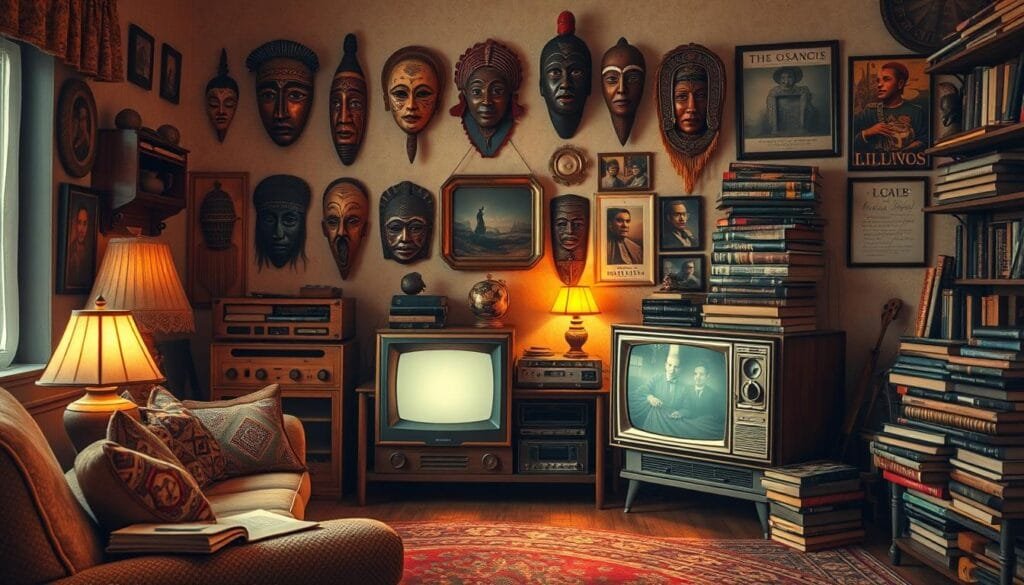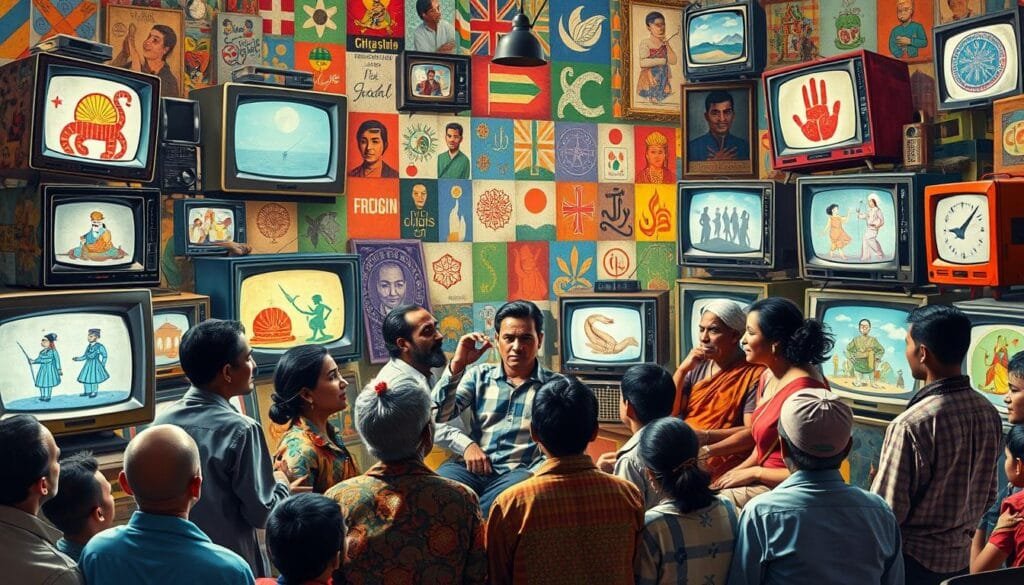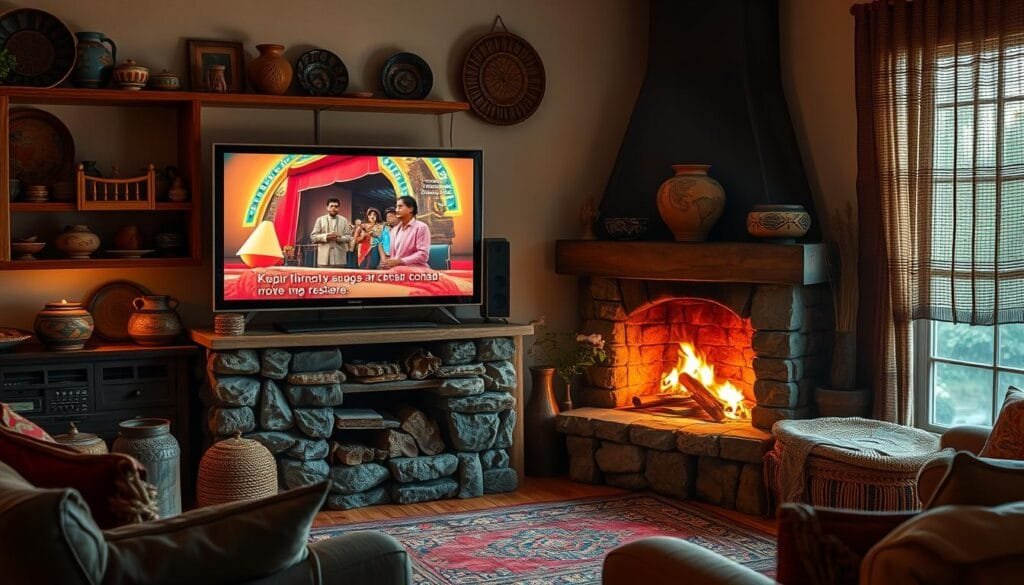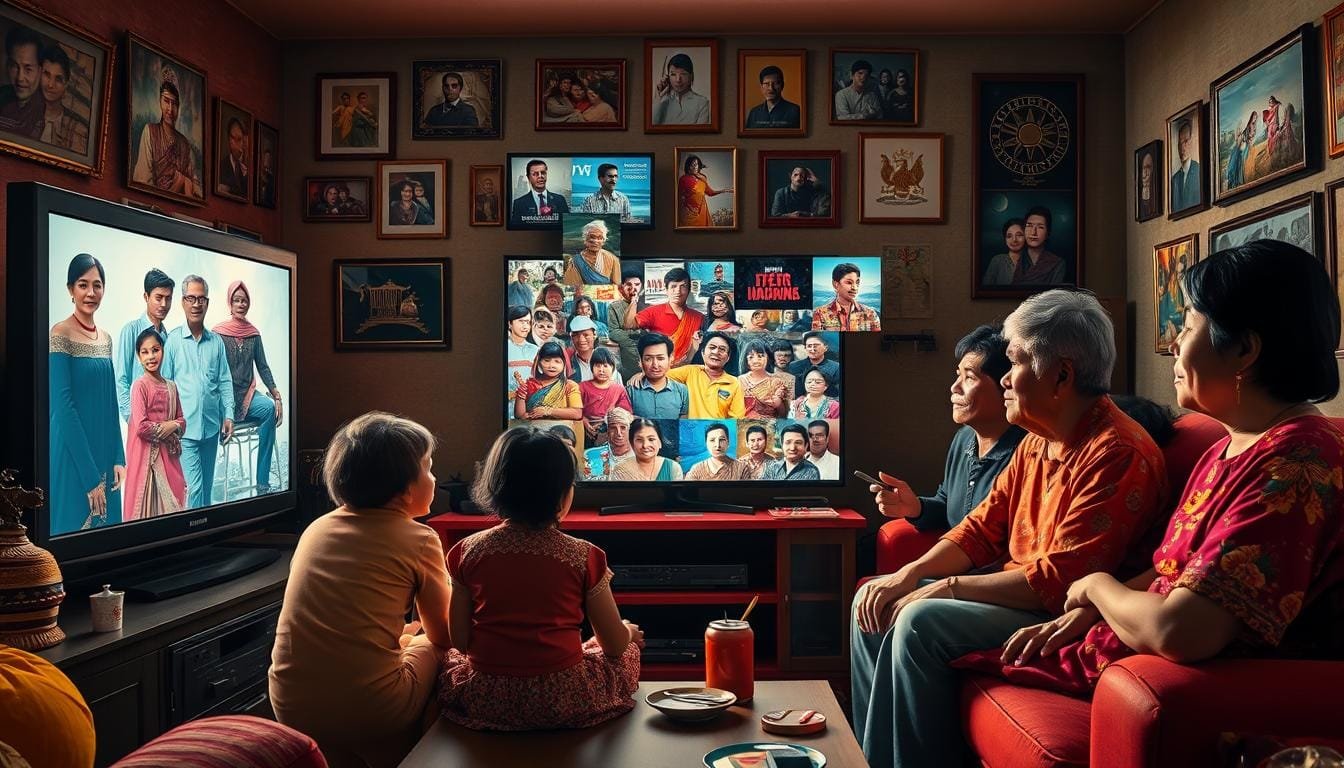Have you ever thought about your TV being more than entertainment? Maybe it’s a modern-day cultural hearth, shaping our society’s values and norms. Let’s see if TV, like old cultural hearths, helps share and keep cultural practices and ideologies alive in our lives.
TV’s cultural impact is huge. It enters our homes, influences our beliefs, and molds public opinion in surprising ways. This guide will explore TV’s effect on society and its role as a cultural hearth today. We’ll look at how TV has spread culture from its start in American homes to its strong influence today.
Key Takeaways
- Television has played a significant role in shaping modern culture and societal norms.
- Cultural diffusion through television can be rapid due to advanced communication technologies.
- Television impacts public opinion, influencing perceptions of authority figures and societal issues.
- Modern communication platforms, including television, facilitate the global spread of cultural ideas.
- The debate on whether television is a cultural hearth continues, with strong arguments on both sides.
- Technological advancements, such as the internet, have further amplified television’s role in cultural transmission.
- Using television effectively as a tool for cultural education requires careful curation of content and active engagement.
Understanding the Concept of Cultural Hearths
Cultural hearths are centers where cultures began and spread across the globe. They have greatly influenced nearby areas by sharing ideas, technologies, and practices.
Definition of Cultural Hearth
A definition of cultural hearth points to an area where cultural traits start. Before they spread to other places. These hearths are key spots for spreading culture. They impact other civilizations and help them evolve.
Historical Examples of Cultural Hearths
There are many examples of cultural hearths that have been key in our history:
- Nile River Valley: It’s one of the first places where communities settled, around 6,000 – 3,000 BC. It’s known as a birthplace of civilization.
- Indus River Valley: The ancient city of Harappa, dating back to 4,000 BCE, was here. This area was a major cultural center.
- Yellow River: Important for being China’s main source of hydroelectric power. It has influenced both ancient and modern tech developments.
The Characteristics of a Cultural Hearth
Understanding the characteristics of cultural hearths shows us their big impact on global cultures. Important features include:
- Population Aggregation: These areas usually have large populations. This makes it easier for ideas and practices to spread.
- Technological Advancements: Breakthroughs in agriculture and urban planning often start in these regions.
- Ideological Innovations: New belief systems and social norms often begin in cultural hearths.
These characteristics of cultural hearths highlight their importance. They’ve shaped civilizations and helped human progress through time.
The Evolution of Television as a Cultural Influence
Television’s arrival in the late 1940s was a major shift. It changed American cultural life from radio’s rule. Television quickly became key in American homes. We’ll see how TV changed fun, opinions, and family life.
Introduction of Television in American Households
Television’s climb in American culture started in the late 1940s. It took over radio as the main source for fun and news. Hits like “I Love Lucy” and “The Ed Sullivan Show” drew in millions. By the 1950s, TVs were often the heart of American living rooms. They changed how families spent their evenings and made watching shows a shared activity.
Television’s Role in Shaping Public Opinion
TV changed public opinion by showing news and live events as they happened. Important moments, like the first moon landing and President Kennedy’s assassination, were seen by people at home. TV made people feel more connected to these events. Thus, it was more than just for fun. It was a strong force in shaping views and feelings.
Impact on Family Dynamics and Daily Life
Television’s effect on family life and daily routines was huge. The TV set turned into the home’s center, where families gathered. “Leave It to Beaver” mirrored and influenced social norms. Ads aimed at viewers changed what people bought and wanted. TV reshaped leisure time, daily plans, and even house designs to fit this new focus.
Television and the Dissemination of Culture
Television plays a big role in spreading culture. It shows us norms and values through different programs. Shows impact things like slang and what we wear. This shows how TV influences our actions and choices in society.
Television as a Medium for Cultural Transmission
Television became a key part of American culture after World War II. It reflects modern American society. Families watch over 8 hours of TV every day, showing its big role in spreading culture. Though early studies saw little change in attitudes from media, newer research shows TV’s wide impact. It focuses on what TV means culturally and how viewers understand it.
Examples of Cultural Programs and Their Impact
Shows like “Sesame Street” and “COSMOS: A Spacetime Odyssey” have taught and shaped values. “Sesame Street” mixes education with fun to impact young learning. “COSMOS” has made people more interested in science. These examples show how TV educates and influences our views and actions.
Television’s Influence on Language and Fashion
TV’s effect on how we talk and dress is clear. Shows such as “Friends” and “Sex and the City” brought new words and styles into the mainstream. Words like “lobster” from “Friends” and outfits from “Sex and the City” show this. TV impacts not just entertainment, but also our expression and fashion choices. It’s a powerful tool in shaping society’s norms and values.

| Aspect | Impact | Examples |
|---|---|---|
| Educational Influence | Enhanced Learning | “Sesame Street”, “COSMOS: A Spacetime Odyssey” |
| Language Influence | Introduction of Slang | “Friends”, “The Simpsons” |
| Fashion Influence | Trend Setting | “Sex and the City”, “Mad Men” |
The Debate: Is Television a Cultural Hearth?
Is TV a key part of our culture? This debate looks closely at TV’s role today. We’ll look at different views, checking out the support and criticism of TV as a cultural influence.
Arguments in Favor
Some people say TV is vital as a cultural center. By the late ’50s, it was where families came together, becoming an “electronic hearth.” TV now has over 500 channels offering a mix of content. This includes shows like Sesame Street and Fraggle Rock, which 98% of people growing up then watched. TV also requires viewers to engage more than movies do, according to McLuhan.
TV unites us during big events like presidential debates and Super Bowls. It shapes our opinions and creates common memories. This shows how wide and deep its influence is.

Arguments Against
But, not everyone thinks TV is good. Critics, like Adorno, believe TV makes content too simple and can manipulate viewers. Since 2012, people have started watching on different devices, reducing the shared experience of TV. The drop in traditional TV and cable viewership backs up this view of fragmentation.
There’s worry about TV’s impact on attention spans, especially with kids who grab new TV tech quickly. This ongoing debate shows how complex TV’s role in society is, without a clear-cut answer.
Expert Opinions and Studies
Experts offer a more balanced view on TV’s impact. By 2000, 98% of American homes had a TV, showing its importance. TV sits between cinema and radio in how it transmits culture. McLuhan talks about an “electronic implosion” that connects viewers worldwide.
Despite criticism, TV’s ability to adapt to new tech keeps it relevant. Networks and VOD services change to fit new viewer demands. Thus, TV still reaches a wide audience, influencing and reflecting our culture.
Comparing Television to Traditional Cultural Hearths
When we compare TV to traditional hearths, we see how TV has changed culture. Like ancient cultural centers, television influences our modern world. It helps us understand both their similarities and differences. Also, it shows how technology affects the spread of culture today versus the past.

Similarities with Ancient Cultural Hearths
TV acts like the heart of cultural spread, just as ancient cultural hearths did. Places like Mesopotamia and the Nile Valley spread ideas and norms far and wide. In a similar way, TV is a key player in spreading pop culture quickly across the globe. This makes it the top activity for fun in many countries.
TV helps shape what we speak, wear, and think about the world. This shows its power as a modern cultural center.
Differences and Unique Aspects
But, TV and ancient hearths have clear differences. Traditional hearths were usually in one place and small. They were found in isolated areas where people shared similar lifestyles. On the other hand, TV reaches everywhere, affecting big, diverse populations all over.
Pop culture changes fast because of this wide reach. Folk culture, however, used to stay the same for a long time.
The Role of Technology in Modern Cultural Hearths
Technology’s role in cultural exchange is huge today. With TV, satellites, and the internet, how we get and share culture has changed completely. Now, even in places where it’s not allowed, people can watch TV from all over the world. This is a big deal in how culture spreads now versus before.
The TV industry’s control by countries like the U.S., U.K., and Japan shows how culture comes from specific places. And with more internet access, the pattern of how we get information looks a lot like early TV days. This connect the past and present in how culture moves around the world.
The Future of Television in the Digital Age
Television is changing quickly in our digital world. We’re seeing new tech and different ways people watch shows. Digital media and streaming services shape the future of TV.
Pat Mitchell, the head of PBS, talks about changing a $2 billion TV organization. The digital world brings big challenges that need careful planning and working with the community. There’s a big push for funding that doesn’t rely so much on gifts or the market.
TV is moving beyond being called a “vast wasteland” by Newt Minow in 1961. Now, we have High Definition (HDTV) and virtual reality. They could completely change how we experience culture. But, switching to these technologies is like buying a small car—it’s very expensive.
Some public TV stations are starting to use digital equipment. But, many people can’t buy HDTV because it’s too pricey, between $2,000 and $4,000. Prices need to drop to around $500 before more people can buy them.
The network TV, cable, and video subscription industries are getting better at making and sending out content more cheaply. People can watch shows on many devices, like phones and tablets. We’ve gone from TV being a family activity to watching alone on a screen.
The future of TV includes finding new ways to make money from new tech but also dealing with less money from old sources. A “technological tsunami” is changing media. Public TV must show how valuable its services are with these changes. Adding artificial intelligence and virtual reality to TV could make watching it a whole new experience. This will help TV stay an important part of our culture.
| Category | Challenges | Opportunities |
|---|---|---|
| Funding Model | Declining traditional support | New revenue from digital technologies |
| Consumer Costs | High costs of HDTV sets and upgrades | Increased affordability over time |
| Technological Integration | Significant adaptation needed | Enhanced viewer experiences with AI and VR |
How to Leverage Television as a Tool for Cultural Education
Television can be a strong tool for cultural learning. It helps families learn together in an engaging way. By picking educational TV wisely, families can learn about different cultures while growing closer.
Selecting Educational Programs
Choosing the right shows is key for cultural learning through TV. It’s best to focus on high-quality programs that show a variety of cultures, historical places, and traditions. For instance, PBS, National Geographic, and educational streaming options have lots of good content. Watching these can make TV time both fun and educational.
Engaging in Family Discussions
After watching an educational show, talking about it as a family is important. This makes watching active, not passive. You can ask questions, share thoughts, and talk more about the themes. This kind of discussion helps everyone understand the culture better.
Using Television as a Supplement to Other Learning Tools
TV should not be the only way to learn. It works best with other methods like books, the internet, and hands-on activities. For example, mix TV learning with visits to places, cooking cultural foods, or looking at cultural items. This matches what some studies suggest about combining TV and education.
By wisely choosing shows, talking about them, and mixing TV with other learning methods, we can use TV to enrich our family’s cultural knowledge. In our digital world, TV is still a valuable tool for learning about cultures. It offers many chances to learn and grow together.
Conclusion
Television has journeyed from its beginning on September 30, 1930, to a key force in today’s society. It started with broadcasts to a few viewers in poor quality. Now, it shapes public opinion and cultural trends powerfully.
Television’s impact as a cultural center is deep and wide-reaching. The Apollo 11 moon landing in 1969 and the 9/11 attacks are key events it has shared. The Live Aid concert in 1985 showed TV’s power to connect the world.
The move from the network era to the multi-channel era, and now to the post-network era, has brought major changes. These include more choice, control, and ways to customize and interact with content. Television keeps up with new tech, impacting how we view and interact with media.
In conclusion, TV remains a vital part of our culture. It continues to influence our values and behaviors. This makes it a lasting element of our cultural scenery.
FAQ
What is the cultural influence of television?
TV shapes our culture in many ways. It affects what we think, wear, and speak. It also changes how families spend time together. TV is a key way culture spreads and grows.
How does TV shape public opinion?
TV changes what people think through news, talk shows, and more. These shows offer different views on what’s happening in the world. They help form our opinions and attitudes.
What are some historical examples of cultural hearths?
Ancient places like Mesopotamia, the Indus Valley, and Egypt are cultural hearths. They were hubs of culture and innovation. Their influence spread far and wide through history.
What characteristics define a cultural hearth?
A cultural hearth influences nearby areas. It’s known for innovation, activity centers, and history. It affects wider cultural trends.
When was television introduced into American households?
TV came to American homes in the late 1940s. By the 1950s, it was a common part of life. It changed media and culture deeply.
How has TV impacted family dynamics and daily life?
TV has changed how families come together. It influences routines and sometimes replaces old ways of bonding. It plays a big part in daily life.
What role does television play in the dissemination of culture?
TV spreads culture widely. It shows different cultural practices, languages, and styles. Through TV, cultural norms reach a global audience.
Can you give examples of cultural programs and their impact?
Shows like “Sesame Street,” international dramas, and documentaries impact us. They educate, promote understanding, and keep culture alive.
How does television influence language and fashion?
TV shapes how we talk and dress. It introduces slang and new fashion trends. Celebrities on TV inspire people to change their style.
What are the arguments in favor of television as a cultural hearth?
Fans say TV is like an ancient cultural hearth. It creates common experiences, drives trends, and forms our cultural identity. It’s a key source of information and fun.
What are the criticisms against television as a cultural hearth?
Critics believe TV promotes stereotypes and consumerism. They worry it leads to less critical thinking and hurts cultural diversity.
What do experts say about television’s impact on society?
Experts have varied opinions. Some see TV’s potential to educate and unite. Others focus on how it spreads misinformation and reduces real interactions. Research covers these complex effects.
How can we compare television to ancient cultural hearths?
Like ancient hearths, TV influences culture. However, it uses technology and has a wider reach. These differences are key.
What are the unique aspects of television compared to traditional cultural hearths?
Television’s impact is immediate and broad. It shares information fast and offers interactive, immersive experiences. These are new compared to old cultural centers.
How does technology play a role in modern cultural hearths like television?
Technology boosts TV’s cultural role. It allows HD, interactive, and on-demand shows. This changes how we share and enjoy culture.
What is the future of television in the digital age?
TV’s future is more online integration, streaming, and personalization. New tech will keep improving how we watch and what we watch.
How can we leverage television for cultural education?
Use TV wisely for learning. Choose educational shows and talk about them with family. It should be part of a broader set of learning tools.
What should we consider when selecting educational television programs?
Look for shows with good content and learning value. They should fit the viewer’s age and encourage thinking and understanding.
How can family discussions enhance learning from television?
Talking about TV shows helps us think deeper. It lets us share views and reinforce what we learn. It brings families closer to what they watch.
How can television be integrated with other learning tools?
Combine TV with books, games, and online resources for a full learning experience. This makes learning varied and more effective.
